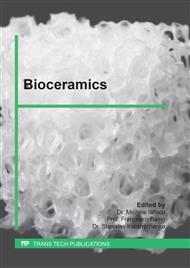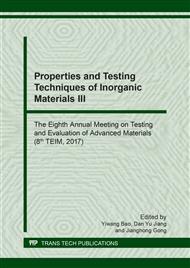p.109
p.114
p.119
p.129
p.135
p.140
p.146
p.152
p.159
Preparation of a Hydroxyapatite Ceramic with Comblike Tubules Structure and its Permeablity
Abstract:
The objectives of this study are to prepare a porous hydroxyapatite ceramic which has dentin tubule-like structure and determine its permeability. Slurry of hydroxyapatite powder, deionized water and a binder was poured into a ring which was placed on a freezing plate.The hydroxyapatite slurry was freezed in a certain rate (by controlling the temperature of the freeze plate at −15°C, −30°C and −45°C) for a certain period of time, then the freezed sample was freezing dried to remove the frozen vehicle, followed by being sintered at 1250 °C for 2 h. After that,the morphology of the cross section and longitudinal section of the sintered porous hydroxyapatite ceramic was observed by SEM and the hydraulic conductance of cross section discs of the sintered porous hydroxyapatite were determined using a self-made micro-flowing permeability tester. Results showed that the prepared hydroxyapatite ceramics having bottom-up unidirectional comblike tubule structure and the tubule diameters associated with the temperature of freezing plate.The ceramic discs prepared on the freezing plate of −45°C exhibited similarity to nature dentin tubule, with a diameter of 9.72±3.41mm and a hydraulic conductance of 0.16±0.09 ml×min-1×cm-2×cm×H2O-1.
Info:
Periodical:
Pages:
135-139
Citation:
Online since:
April 2018
Authors:
Keywords:
Price:
Сopyright:
© 2018 Trans Tech Publications Ltd. All Rights Reserved
Share:
Citation:



